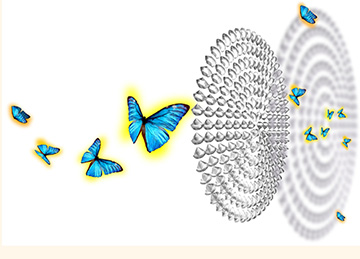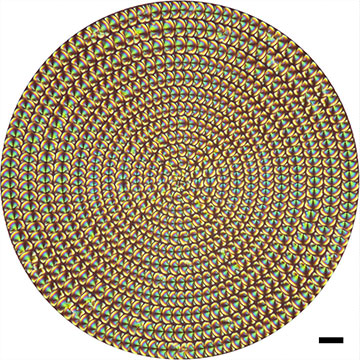
As suggested in this drawing, a concentric array of deformed liquid-crystal microlenses, developed by scientists at Nanjing University and several other institutions in China, can extract information on both image depth and light polarization, based on where the image best focuses in the array. [Image: L.-L. Ma et al., ACS Nano, doi: 10.1021/acsnano.9b07104]
Optical scientists have long been fascinated by the visual system of the mantis shrimp, a marine crustacean whose eyes process information about both the color and the polarization of light. Those capabilities have served as inspiration for a number of optical devices designed extract both 3-D spatial and polarization information simultaneously. But it’s been tough to wedge both features into a compact optical package.
A research team in China now proposes a novel approach to capturing both types of image data in a single shot (ACS Nano, doi: 10.1021/acsnano.9b07104). The team’s “4-D” approach relies on a clever, concentric configuration of liquid-crystal (LC) microlenses that allows information on depth and polarization to be determined based on which microlens within the array provides the sharpest image of the target. While at present the design constitutes only a proof of principle, the researchers believe it could ultimately prove useful in applications ranging from medical imaging and remote sensing to information encryption.
Capturing different properties
One reason it’s been difficult to get to a lens that can process both 3-D depth and polarization information is that the sensing of the two relies on different properties—the spatial refractive-index distribution in the case of depth focusing, and characteristics such a birefringence in the case of polarization. LC lenses, which have tunable birefringence and refractive-index distribution, would seem to be a good candidate for simultaneously capturing both kinds of data. But unfortunately, tweaking LC lenses’ polarization dependence can impose a hit on optical efficiency and imaging quality.
The Chinese research team, led by Wei Hu and OSA Fellow Yan-qing Lu of Nanjing University, considered a different way of leveraging the strengths of LC lenses. They reasoned that, by playing with the geometry and relative sizes of an array of deformable LC microlenses, they could trick an imaging system into revealing polarization and depth information at the same time.
Half-moon shapes
The lens design consists of deformed, half-moon-shaped liquid-crystal lenses arranged in concentric rings, with the lens size increasing in each ring moving out from the center of the array. Scale bar: 20 μm. [Image: L.-L. Ma et al., ACS Nano, doi: 10.1021/acsnano.9b07104] [Enlarge image]
The specific configuration that the team developed begins with smectic LC microlenses, around 10 μm or less in diameter, that are deformed into half-moon shapes that allow them to focus light only in a single polarization direction. The team then arranged the lenses (using spin coating onto a photoalignment layer) into a series of concentric rings, with the size of the individual lenses in each ring increasing as one moves out from the center of the array.
The specific arrangement means that the alignment direction of the half-moon lenses varies continuously according to the azimuthal angle (the clockwise angle around the center of the concentric array). Thus, the sharpness of an image in light of a specific polarization should also vary azimuthally, with microlenses in a particular quadrant providing the crispest images and with other areas comparatively blurred. At the same time, the radial increase in lens size from the center of the array outward means that the focal length also varies radially. That means that information about depth can be gained by the radial position of the lens that offers the sharpest image.
The researchers tested their array with simple letter-shaped imaging targets transmitting different light polarizations, and found that both the polarization selectivity and the multifocal depth imaging worked in the expected way. They also imaged two objects with different depth and polarization characteristics at the same time, and were able to successfully demultiplex the depth and polarization data in the microlens-array images.
Improving the system
The team stresses that this demo constitutes only a proof of concept, with a number of hurdles still to be overcome toward practical application. One of those lies in some of the optical details—the proposed array, the authors write, “still suffers from restricted tunable range of size and imperfect phase profiles.” But they believe that the LC-array platform offers sufficient flexibility to overcome these problems, and that extending the basic idea to other materials, such as nematic LCs, birefringent crystals and even artificial metasurfaces, could provide another avenue for improving image quality and resolution.
Meanwhile, the authors are looking ahead to applications of their asymmetric microlens arrays, which they argue “provide a convenient method for visualizing 4-D information on the target.” For example, they note that a CCD imager could be placed behind the lens to capture information from the lens array, and moved precisely with a micromotor to allow mutifocal imaging at a rapid clip. Such a method, they conclude, could find a place in “forward looking applications such as optical parallel detection, stereo-pico-projection, full-dimension autoaligning …, polarization-selective remote sensing and information encryption.”
In addition to researchers at Nanjing University, the study also included authors from the Institute for Smart Liquid Crystals, Changshu, China; Nanjing Tech University, Nanjing, China; and Soochow University, Suzhou, China.

